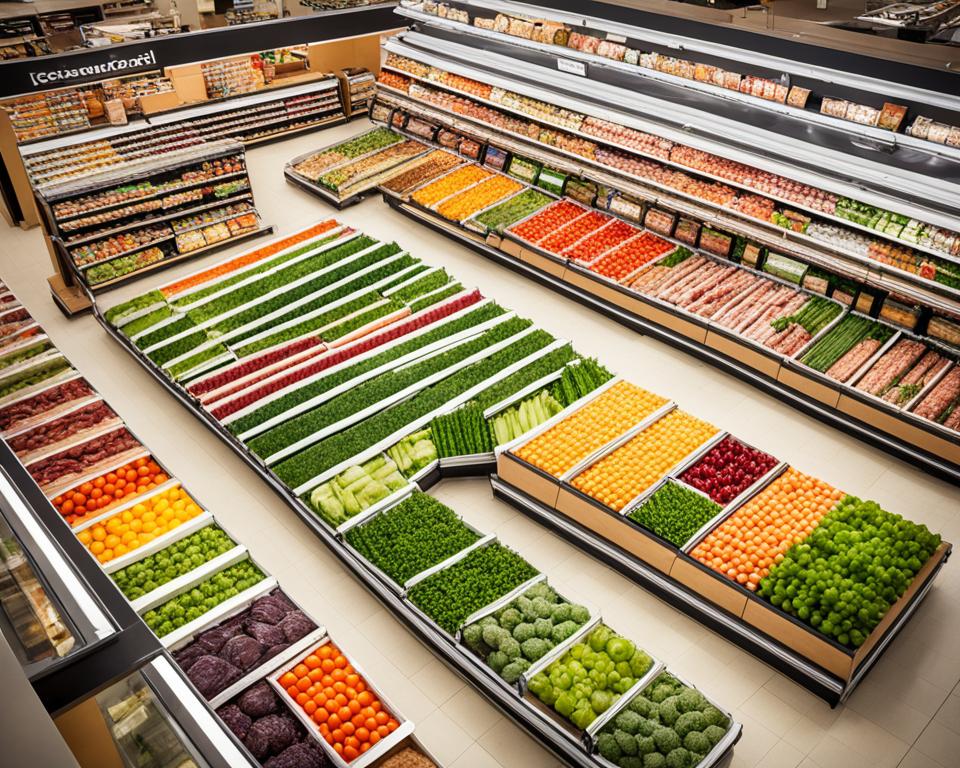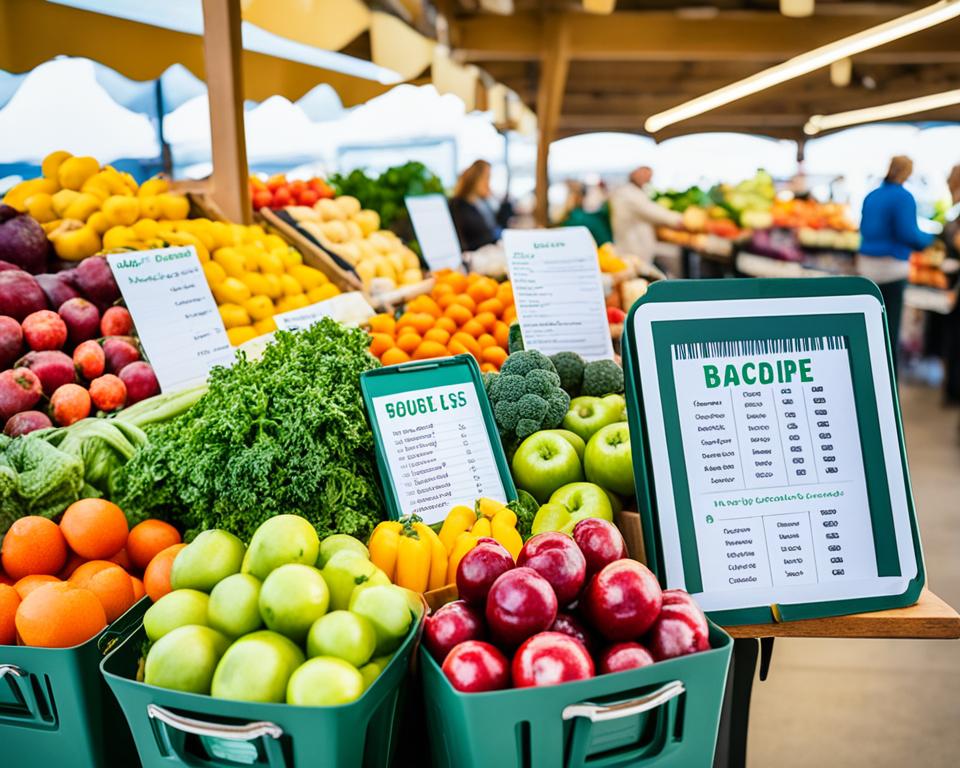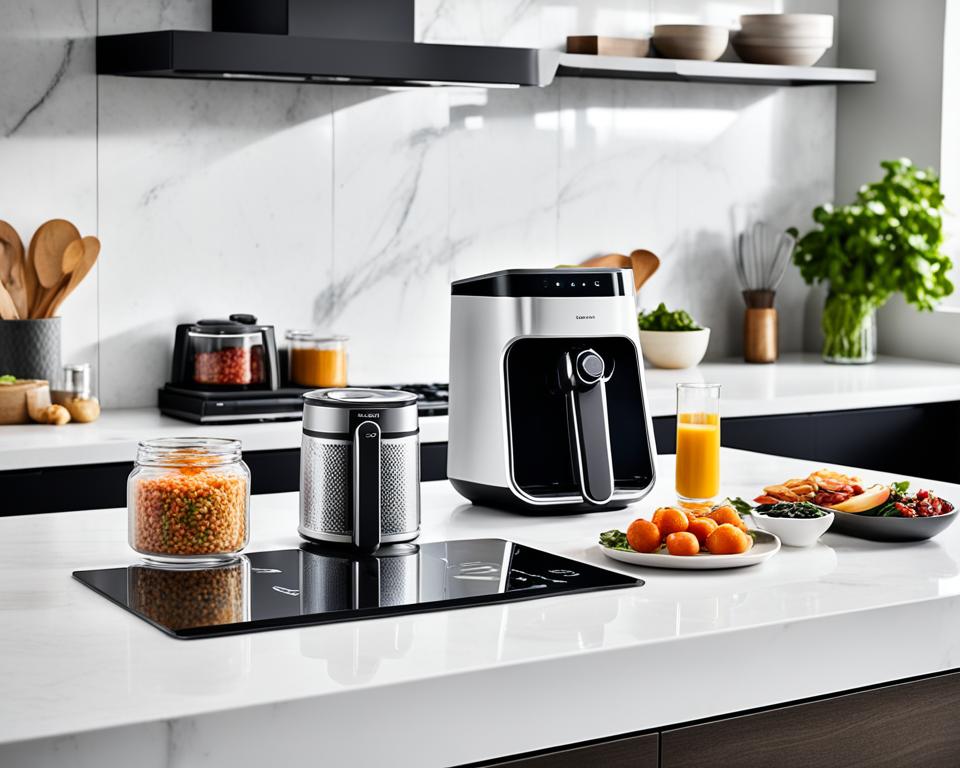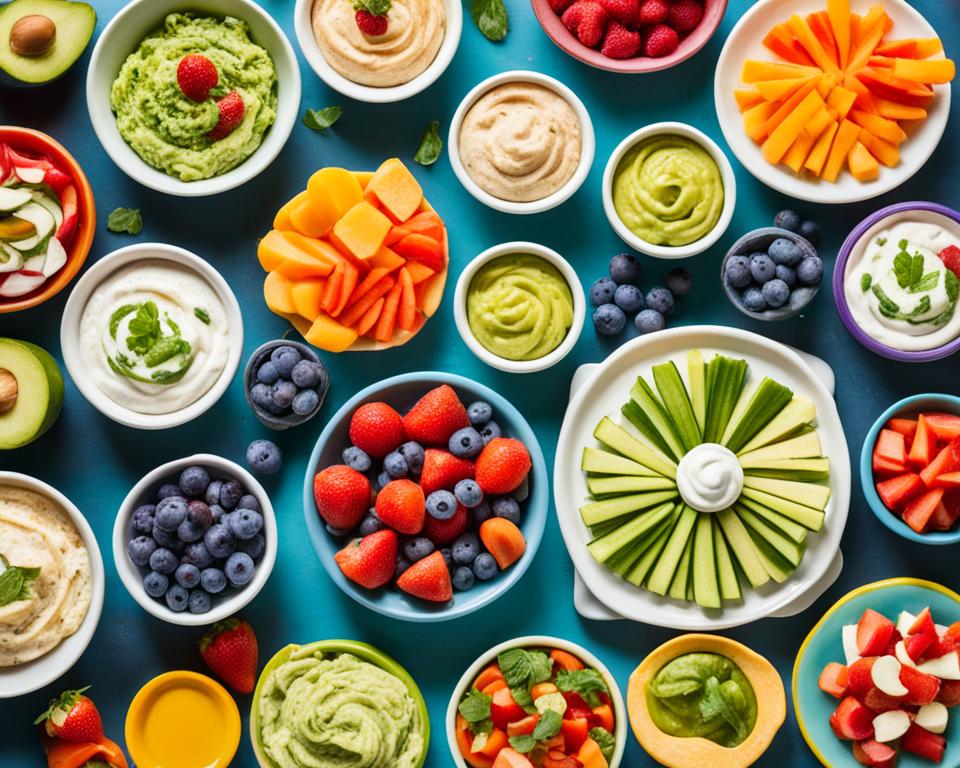In today’s economy, finding ways to save money on groceries has become more important than ever. With rising prices and increasing budget constraints, it’s crucial to discover strategies that allow us to cut costs without compromising on the quality of the food we purchase. In this article, we will explore some effective techniques for frugal and budget-friendly grocery shopping that will help us make smart and cost-effective choices. By implementing these strategies, we can reduce our grocery expenses while still enjoying the delicious and nutritious meals we love.
Key Takeaways:
- Create a meal plan and stick to it to avoid unnecessary purchases and wastage.
- Consider shopping alone to prevent impulse buying and staying focused on your shopping list.
- Shop during the quietest days of the week to find the best prices and cost-effective options.
- Swap expensive cuts of meat for more affordable alternatives to save money.
- Choose generic products instead of name brands to reduce your grocery bill without compromising on quality.
Make a meal plan
Planning your meals for the week is an excellent way to save money and avoid buying unnecessary items. By creating a meal plan and sticking to it, you can avoid waste and overspending at the grocery store. Start by deciding what meals and snacks you’ll eat during the week and make a grocery list based on those choices. This will help you avoid impulse purchases and stay focused on buying only what you need.
Meal planning not only helps you save money but also ensures that you have nutritious and balanced meals throughout the week. It allows you to be intentional about your food choices and helps you avoid falling into the trap of ordering takeout or grabbing unhealthy snacks on the go.
When creating your meal plan, consider any dietary restrictions or preferences you may have, as well as the ingredients you already have in your kitchen. This will help you make the most of what you already have and minimize food waste.
Once you have your meal plan for the week, create a detailed grocery list. Organize it by categories such as fruits and vegetables, grains, proteins, and pantry staples. This will make your shopping trip more efficient, saving you time and reducing the chances of forgetting essential items.
Meal planning allows you to take control of your grocery spending and make intentional choices that align with your budget and nutritional goals. It also helps you avoid last-minute trips to the store, where you may end up buying unnecessary items.
So, grab a pen and paper, or use a meal planning app, and start planning your weekly meals. Not only will it save you money, but it will also make your life easier and more organized.
Shop alone if you can
When it comes to grocery shopping, going alone can be a game-changer. Shopping with children or a partner can often lead to impulse buying and unnecessary purchases. We’ve all been there, grabbing items off the shelf on a whim, only to regret it later when we see our grocery bill.
That’s why it’s important to try and shop alone whenever possible. When you’re shopping solo, you have more control over your purchasing decisions and can stick to your list without distractions. You can take your time, compare prices, and make informed choices about what goes in your cart.
If your family members have specific requests or items they need, be sure to add them to your shopping list in advance. This way, you can ensure that those items are included without the risk of additional impulse buys. By sticking to your list and avoiding those last-minute purchases, you’ll not only save money but also reduce food waste.
So the next time you’re heading to the grocery store, go solo and avoid the temptation of impulse buying. Your wallet will thank you!
Benefits of Shopping Alone:
- Avoid impulse buying and unnecessary purchases
- Stick to your shopping list
- Compare prices and make informed choices
Quote:
“Shopping alone allows me to focus on my needs and budget. I can resist the temptation of impulse buying and stick to my grocery list, saving money in the process.” – Sarah
Shop during the quietest days of the week
When it comes to grocery shopping, timing is everything. Shopping during busy times can be overwhelming, chaotic, and make it difficult to find the best prices and cost-effective options. That’s why it’s important to identify the quietest days at your preferred grocery store and plan your shopping trips accordingly.
By shopping during quieter times, you can avoid crowds, take your time to navigate the aisles, compare prices, and find the most cost-effective products. Not only will this save you money on groceries, but it can also make your shopping experience more enjoyable and stress-free.
Each grocery store may have different quiet shopping days, so it’s important to observe and determine the patterns at your specific store. Here are a few tips to help you identify the quietest days:
- Visit the store during weekdays, especially on Tuesdays and Wednesdays, as these tend to be quieter compared to weekends.
- Consider going early in the morning or later in the evening, as these are typically less crowded times.
- Monitor the store’s parking lot – if it’s less crowded, it’s likely an indicator of a quieter shopping experience.
By strategically planning your grocery shopping trips during quieter days, you can enjoy a more serene environment, avoid long lines, and discover the best cost-effective options for your budget.
Remember, finding quiet shopping days is just one of the many strategies for saving money on groceries. Make sure to continue reading for more tips on how to avoid crowds, find cost-effective options, and maximize your grocery savings.
Swap expensive cuts of meat for cheaper options
When it comes to cost-effective grocery shopping, one area where you can make significant savings is with your meat purchases. Instead of opting for expensive cuts of meat, consider swapping them for more affordable alternatives like ground turkey or chicken. By making this simple substitution, you can still enjoy delicious meals while stretching your budget.
Many people are accustomed to purchasing higher-end cuts of meat, assuming they are necessary for flavorful dishes. However, there are plenty of cheaper options available that can be just as tasty when prepared properly. For example, grass-fed beef tends to be more expensive than grain-fed beef. By incorporating more affordable cuts of meat into your meals, you can still enjoy the flavors you love while saving money on groceries.
Here’s an idea: instead of solely relying on expensive cuts of beef for your steak night, consider trying other cuts like flank steak or skirt steak, which tend to be more affordable. Marinated and cooked correctly, these cuts can be just as tender and flavorful as the pricier options.
“By swapping expensive cuts of meat for cheaper alternatives, you can significantly reduce your grocery bill while still enjoying delicious and satisfying meals.”
Meat alternatives are also worth considering if you’re looking to save money. Plant-based proteins, such as tofu, tempeh, and seitan, offer affordable and nutritious options for your meals. These alternatives can be just as versatile as meat, allowing you to create a variety of dishes while keeping your grocery expenses in check.
With a little creativity and willingness to explore different options, you can find affordable meat choices that fit within your budget. By incorporating cheaper cuts of meat and exploring meat alternatives, you can save money on groceries while still enjoying delicious and nutritious meals.
Buy generic products
Purchasing generic or store-brand products can significantly reduce your grocery bill. These products are often manufactured in the same facilities as name-brand items and offer similar quality but at a lower price. Save money by choosing generic options whenever possible.
When it comes to saving money on groceries, generic brands and store brands are your secret weapons. These affordable options provide excellent value for the price, allowing you to stretch your budget further. Many people are hesitant to try generic products, fearing they may be of inferior quality or taste. However, this couldn’t be farther from the truth.
Generic products are often made by the same manufacturers as their branded counterparts, using the same ingredients and production processes. The main difference lies in the packaging and marketing. By eliminating the extra advertising and fancy packaging, generic brands can offer their products at a lower cost.
When shopping for groceries, pay attention to generic alternatives for commonly used items such as cereals, canned goods, snacks, cleaning supplies, and even medications. You’ll be pleasantly surprised by the quality and savings you can achieve. By incorporating more generic products into your shopping list, you can significantly reduce your grocery expenses without sacrificing quality or taste.
Why choose generic brands?
1. Cost-effective shopping: Generic brands are typically priced lower than their branded counterparts, making them an affordable option for cost-conscious shoppers. By choosing generic products, you can maximize your savings and get more value for your money.
2. Similar quality: As mentioned earlier, generic brands are often produced alongside name-brand items in the same facilities. This means that the quality of the products is comparable, if not identical, to the branded versions.
3. Variety of options: Generic brands offer a wide range of options across various categories, allowing you to find affordable alternatives for almost any item on your shopping list. From pantry staples to personal care products, there’s likely a generic brand available for your needs.
4. Trusted by consumers: Generic brands have gained popularity and trust among consumers over the years. Many people have had positive experiences with generic products and continue to choose them for their reliability and affordability.
Save money with generic brands
Are you ready to start saving money on your groceries? Here’s how you can incorporate more generic brands into your shopping routine:
- Create a list: Before heading to the grocery store, make a list of the items you need. Include generic options for the products you frequently purchase.
- Compare prices: Take the time to compare prices between generic and branded products. In many cases, you’ll find that the generic version offers significant savings.
- Try new products: Don’t be afraid to try new generic products. You might discover hidden gems that not only save you money but also become your new favorites.
Remember, buying generic brands doesn’t mean compromising on quality. It’s about being a smart shopper and choosing affordable options that meet your needs. By making the switch to generics, you’ll be able to save money on groceries without sacrificing taste or quality.
Stick to the store’s perimeter
When it comes to saving money on groceries, one strategy that can make a significant difference to your budget is sticking to the store’s perimeter. The outer perimeter of the grocery store is where you’ll typically find a variety of fresh fruits, vegetables, and other unprocessed foods. These options are generally more cost-effective compared to the processed and packaged items found in the center aisles.
By focusing your shopping on the store’s perimeter, you can plan healthier meals and avoid expensive processed foods. Not only will you be making healthier choices for yourself and your family, but you’ll also be saving money in the process. Unprocessed foods are often priced more affordably, allowing you to stretch your grocery budget further.
Remember the phrase “Eye level is buy level” when you’re shopping. Retailers strategically place higher-priced items at eye level, making them more tempting to purchase. Be mindful of where products are placed on shelves and take the time to compare prices before making a decision. By being intentional with your shopping and sticking to the store’s perimeter, you can save money while still enjoying nutritious and delicious meals.

| Benefits of Sticking to the Store’s Perimeter |
|---|
| Cost-effective options |
| Access to fresh fruits and vegetables |
| Healthier meal choices |
| Avoidance of expensive processed foods |
| Opportunity for better meal planning |
| Savings on your grocery bill |
Pay with a grocery rewards card
When it comes to saving money on groceries, utilizing a grocery rewards card can be a game-changer. These cards offer cash back or other rewards for your supermarket purchases, allowing you to earn back a portion of your spending. By taking advantage of a grocery rewards card, you can offset the impact of inflation and enjoy the rewards and benefits that come with it.
How Does it Work?
When you make purchases at supermarkets using a grocery rewards card, you accumulate points or cash back based on your spending. These rewards can then be redeemed for a variety of benefits, including discounts on future grocery purchases, gift cards, or even travel rewards.
“Using a grocery rewards card is like getting paid to shop for groceries. It’s a win-win situation – you save money on groceries while earning valuable rewards!”
Choosing the Right Grocery Rewards Card
When selecting a grocery rewards card, it’s essential to compare different options to find the one that best suits your needs and shopping habits. Consider factors such as the cash back percentage, any additional fees or requirements, and the availability of rewards that align with your preferences.
To help you get started, here’s a comparison table of popular grocery rewards cards:
| Card Name | Cash Back Percentage | Annual Fee | Additional Rewards |
|---|---|---|---|
| SuperSaver Card | 2% | $0 | Extra points for fuel purchases |
| GroceryMax Rewards | 1.5% | $25 | Discounts on partner restaurants |
| MegaSave Mastercard | 3% | $50 | Airline miles for travel |
Remember, every individual’s needs and preferences are different, so choose the grocery rewards card that aligns with your goals and spending habits.
With a grocery rewards card in your wallet, you can not only save money on groceries but also earn valuable rewards along the way. So why wait? Start reaping the benefits today!
Conclusion
Saving money on groceries is essential for staying within our grocery budgets. By implementing these effective strategies, you can reduce your grocery expenses without compromising on the quality of the food you buy.
One of the most impactful strategies is creating a meal plan and sticking to it. This helps you avoid impulse purchases and waste, ensuring that you only buy what you need. Additionally, shopping alone allows you to focus on your list and avoid unnecessary spending.
Timing is also crucial when it comes to saving money. Shopping during quieter days allows you to compare prices and find the most cost-effective options. Swapping expensive cuts of meat for more affordable alternatives and buying generic products can significantly lower your grocery bill without sacrificing quality.
Finally, take advantage of grocery rewards cards that offer cash back and other benefits. Utilizing these cards can further reduce your expenses and make smart grocery shopping a rewarding experience.
Remember, being mindful of your spending, comparing prices, and making informed choices are key to maximizing your grocery savings. With these strategies, you can stay within your budget without compromising on the essentials and enjoy quality meals at a cost-effective price.
FAQ
What are the best strategies for saving money on groceries without sacrificing quality?
There are several effective strategies you can use to save money on groceries without compromising on quality. These include making a meal plan, shopping alone, choosing the quietest shopping days, swapping expensive cuts of meat for cheaper alternatives, buying generic products, sticking to the store’s perimeter, and utilizing a grocery rewards card. By implementing these strategies, you can reduce your grocery expenses and stay within your budget.
How can meal planning help save money on groceries?
By creating a meal plan and sticking to it, you can avoid unnecessary purchases and waste. Meal planning helps you know exactly what meals and snacks you’ll be having for the week, allowing you to create a grocery list based on those items. This prevents impulse buying and helps you stay focused on buying only what you need, ultimately saving money on groceries.
Why is it beneficial to shop alone when grocery shopping?
Shopping alone can reduce the chances of impulse buying and unnecessary purchases. When you shop with children or a partner, their preferences may influence your buying decisions, leading to extra items in your cart. To save money, try to shop alone whenever possible. If your family members have specific requests, add those items to your shopping list in advance to ensure they are included without the risk of additional impulse buys.
What are the advantages of shopping during the quietest days of the week?
Shopping during quieter times allows you to take your time, compare prices, and find the most cost-effective products. When the store is less crowded, you’ll have a better chance of finding the best prices and accessing cost-saving options. By planning your shopping trips during the quietest days, you can save money on groceries and make more informed purchasing decisions.
How can I save money on meat without compromising on quality?
Consider substituting expensive cuts of meat with more affordable options like ground turkey or chicken. By incorporating cheaper alternatives into your meals, you can still enjoy delicious and nutritious dishes while reducing costs. Additionally, if you typically purchase higher-end cuts of meat, consider reducing expenses by incorporating more affordable options into your meals. For example, grass-fed beef is often more expensive than grain-fed beef, so consider swapping out some grass-fed beef for more affordable options.
Why should I consider purchasing generic or store-brand products?
Generic or store-brand products are often manufactured in the same facilities as name-brand items and offer similar quality but at a lower price. By choosing generic options whenever possible, you can significantly reduce your grocery bill without sacrificing the quality of your food. This is a great way to save money on groceries while still enjoying the products you love.
What are the benefits of sticking to the store’s perimeter when grocery shopping?
The outer perimeter of the grocery store is where you’ll typically find unprocessed foods like fruits, vegetables, dairy, and meat, which are generally more cost-effective than the processed items in the center aisles. Shopping around the perimeter can help you plan healthier meals and save money by avoiding expensive processed foods. Remember the phrase “Eye level is buy level” and be mindful of where products are placed on shelves to make smart choices and maximize your grocery savings.
How can a grocery rewards card help me save money on groceries?
Utilizing a grocery rewards credit card can help you save money on groceries by offering cash back or other rewards for purchases made at supermarkets. By using a grocery rewards card, you can earn a percentage of your spending back in the form of cash or other rewards, offsetting the cost of inflation. Be sure to compare different rewards cards and choose one that best suits your needs and shopping habits to maximize your grocery savings.
How can I effectively reduce my grocery expenses and stay within my budget?
By creating a meal plan, shopping alone, shopping during quieter times, choosing cheaper meat options, buying generic products, sticking to the store’s perimeter, and utilizing rewards cards, you can save money on groceries while still enjoying quality food. These strategies can help you reduce your grocery expenses and stay within your budget without sacrificing the essentials. Remember to be mindful of your spending, compare prices, and make smart choices to maximize your grocery savings.





